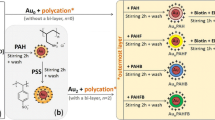Abstract
Naphthyridine-based receptors 1–4 have been designed and synthesized for the recognition of urea in CHCl3 containing 1% CH3CN. Receptor 1 also binds biotin and its methyl ester with moderate binding constant values. In comparison, receptor 2 is less efficient in recognising biotin and its methyl ester analogue. Receptor 1 binds urea and biotin with binding constant values of 1.02 × 104 and 1.08 × 104 M−1, respectively, in CHCl3 containing 1% CH3CN and shows significant change in emission of naphthyridine upon complexation. Characterization and sensing properties of the receptors were evaluated by 1H NMR, UV–vis and fluorescence spectroscopic methods.
















Similar content being viewed by others
Notes
Energy minimization was carried out using MMX (PC Model Serena Software (1993). Molecular modeling was performed using standard constants, and the dielectric constant was maintained at 1.5.
References
Dugas, H.: Bio-organic Chemistry. Springer, New York (1996)
Lehn, J.M.: Supramolecular Chemistry. VCH, Weinheim (1995)
Pedersen, C.J.: Crystalline complexes of macrocyclic polyethers with thiourea and related compounds. J. Org. Chem. 36, 1690 (1971)
Goswami, S., Dey, S.: Directed molecular recognition: design and synthesis of neutral receptors for biotin to bind both its functional groups. J. Org. Chem. 71, 7280 (2006). and references cited therein
Mazik, M., Kuschel, M., Sicking, W.: Crown ethers as building blocks for carbohydrate receptors. Org. Lett. 8, 855 (2006). and references cited therein
Goswami, S., Ghosh, K., Dasgupta, S.: Troger’s base molecular scaffolds in dicarboxylic acid recognition. J. Org. Chem. 65, 1907 (2000)
Wang, H., Chan, W.-H., Lee, A.W.M.: Cholic acid-based fluorescent probes for enantioselective recognition of trifunctional amino acids. Org. Biomol. Chem 6, 929 (2006)
Cooke, I.J.: Toxic effect of urea on plants. Nature 194, 1262 (1962)
Morris, J.G., Payne, E.: Ammonia and urea toxicoses in sheep and their relation to dietary nitrogen intake. J. Agric. Sci. 74, 259 (1970)
Goswami, S., Mukherjee, R., Ray, J.: Design and synthesis of a neutral fluorescent macrocyclic receptor for the recognition of urea in chloroform. Org. Lett. 7, 1283 (2005)
Chetia, B., Iyer, P.K.: 2, 6-Bis(2-benzimidazolyl)pyridine receptor for urea recognition. Tetrahedron Lett. 47, 8115 (2006)
Ghosh, K., Masanta, G.: Anthracene-based open and macrocyclic receptors in flurometric detection of urea. New J. Chem. 33, 1965 (2009)
van Staveren, C.J., Aarts, V.M.L.J., Grootenhuis, P.D.J., Droppers, W.J.H., van Eerden, J., Harkema, S., Reinhoudt, D.N.: Synthetic molecular receptors for urea macrocyclic ligands with intraannular acidic groups and the complexes with urea. J. Am. Chem. Soc. 110, 8134 (1988). and references cited therein
van Staveren, C.J., van Eerden, J., Veggel, F.C.J.M., Herkema, S., Reinhoudt, D.N.: Cocomplexation of neutral guests and electrophilic metal cations in synthetic macrocyclic hosts. J. Am. Chem. Soc. 110, 4994 (1988)
Bell, T.W., Liu, J.: Hexagonal lattice hosts for urea: a new series of designed heterocyclic receptors. J. Am. Chem. Soc. 110, 3673 (1988)
Ghosh, K., Adhikari, S., Frohlich, R.: A pyridine-based macrocyclic host for urea and acetone. Tetrahedron Lett. 49, 5063 (2008)
Goswami, S., Mukherjee, R.: Molecular Recognition: A simple dinaphthyridine receptor for urea. Tetrahedron Lett. 38, 1619 (1997)
Nelson, D.L., Cox, M.M.: Lehninger Principles of Biochemistry, 3rd edn. Worth Publishers, New York (2000)
Traub, W.: Crystal structure of biotin. Nature (London) 178, 649 (1956)
Adrian Jr, J.C., Wilcox, C.S.: Orderly Functional Group Dyads. Recognition of biotin and adenine derivatives by a new synthetic host. J. Am. Chem. Soc. 111, 8055 (1989)
Herranz, F., Santa-María, M.D., Claramunt, R.M.: Molecular recognition: improved binding of biotin derivatives with synthetic receptors. J. Org. Chem. 71, 2944 (2006)
Ghosh, K., Sen, T.: A benzthiazole-based simple receptor in fluorescence sensing of biotin ester and urea. Tetrahedron Lett. 50, 4096 (2009)
Ghosh, K., Sarkar, A.R., Sen, T.: Naphthyridine-based symmetrical and unsymmetrical pyridinium amides in sensing of biotin salt. Supramol. Chem. doi: 10.1080/10610270903089738 (2009)
Ghosh, K., Sen, T., Frohlich, R.: A naphthyridine-based receptor for sensing citric acid. Tetrahedron Lett. 48, 2935 (2007)
Newkome, G.R., Garbis, S.J., Majestic, V.K., Fronczek, F.R., Chiari, G.: Chemistry of heterocyclic compounds. 61 Synthesis and conformational studies of macrocycles possessing 1,8- or 1,5-naphthyridino subunits connected by carbon-oxygen bridges. J.Org. Chem. 46, 833 (1981)
de Silva, A.P., Gunaratne, H.Q.N., Gunnlaugsson, T., Huxley, A.J.M., McCoy, C.P., Rademacher, J.T., Rice, T.E.: Signaling recognition events with fluorescent sensors and switches. Chem. Rev. 97, 1515 (1997)
Chou, P.T., Wu, G.R., Wei, C.Y., Cheng, C.C., Chang, C.P., Hung, F.T.: Excited-state amine-imine double proton transfer in 7-azaindoline. J. Phys. Chem. B 104, 7818 (2000)
Kryachko, E., Nguyen, M.T., Zeegers-Huyskens, T.: Thiouracils: acidity, basicity, and interaction with water. J. Phys. Chem. A 105, 3379 (2001)
Colquhoun, H.M., Goodings, E.P., Maud, J.M., Stoddart, J.F., Wolstenholme, J.B., Williams, D.J.: The complexation of the diquat dication by dibenzo-3n-crown-n-ethers. J. Chem. Soc., Perkin II. 607 (1985)
Acknowledgements
We thank DST, Government of India for providing facilities in the department under DST FIST program. TS thanks CSIR, Government of India for a fellowship.
Author information
Authors and Affiliations
Corresponding author
Electronic supplementary material
Below is the link to the electronic supplementary material.
Rights and permissions
About this article
Cite this article
Ghosh, K., Sen, T. Naphthyridine-based receptors for flurometric detection of urea and biotin. J Incl Phenom Macrocycl Chem 67, 271–280 (2010). https://doi.org/10.1007/s10847-009-9707-6
Received:
Accepted:
Published:
Issue Date:
DOI: https://doi.org/10.1007/s10847-009-9707-6




